
Recipients of The John Thornton Award:
2021: Paul Rinaldi
(Presented on Dec. 9, 2021 at the 18th Biennial Convention in Houston.)
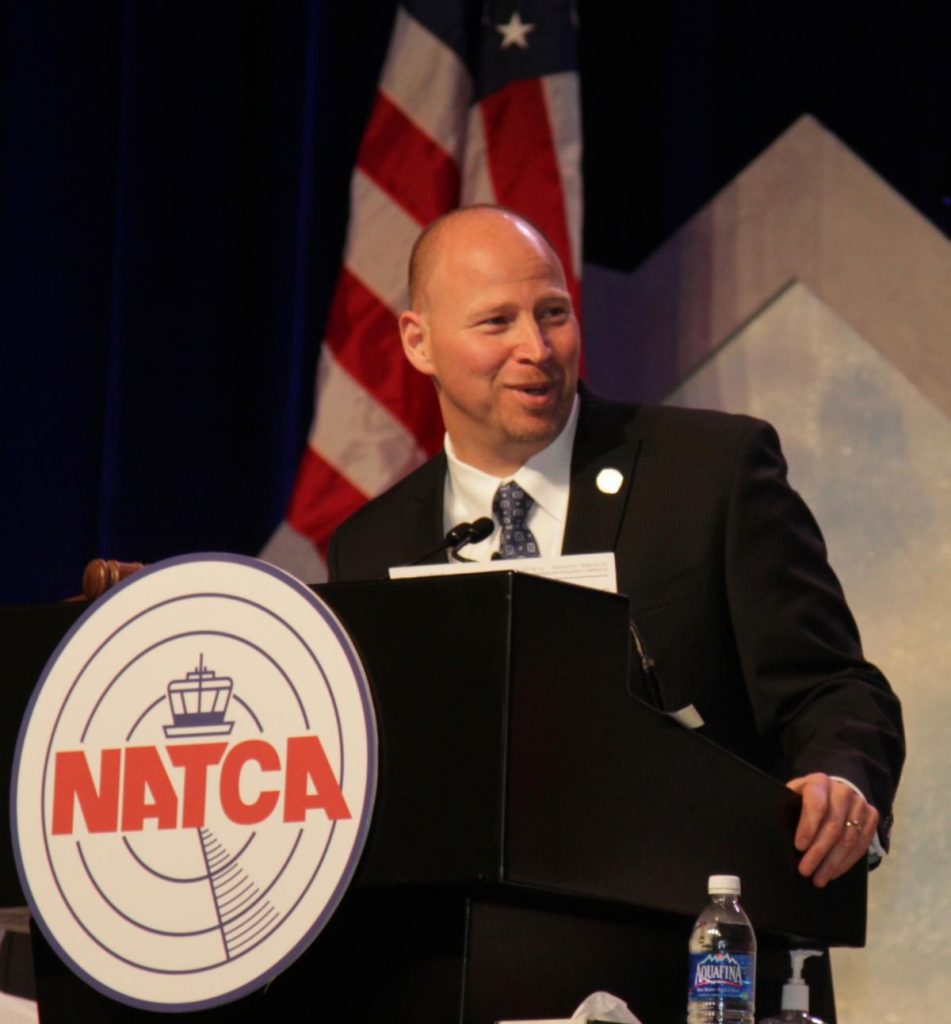
In 2014, Paul Rinaldi stood before the 15th Biennial Convention body in Minneapolis and honored the memory of John Thornton by sharing important details of who he was. Thornton was NATCA’s most important founder. He sacrificed his job as a member of PATCO and even went to jail. But he did not turn his back on the profession or those hired after the 1981 strike. He did the opposite. He led a new effort to unionize them in the mid-1980s. The result was the birth and certification of NATCA while the same president who fired Thornton and more than 11,000 others was still in office.
During that speech in Minneapolis, Rinaldi announced the creation of the John Thornton Award and presented the first one to Thornton’s widow, Ginny. The John Thornton Award is the most prestigious honor NATCA has for its most impactful leaders. It recognizes extraordinary contributions that have significantly changed the course of NATCA’s history.
On Dec. 9 at the 18th Biennial Convention in Houston, Rinaldi himself was honored with the John Thornton Award.
“Like John Thornton, Paul Rinaldi embodies every great characteristic of a union member,” said President Rich Santa in introducing Rinaldi (who was not able to attend) as the ninth and newest recipient of the award. “But he will be the first to tell you that while he served as executive vice president and then president for nearly half of NATCA’s entire existence, he stood on the shoulders of those who came before him and built the Union’s foundation from the cornerstone up.”
Rinaldi walked into the tower cab at Washington Dulles 30 years ago and plugged into a job he loved so much. But soon after, he began to find ways to volunteer his time to help his Union and his profession. Within four years, he was elected Dulles vice president. He became FacRep a year after that and he was off and running. He heard his calling and it was to lead.
He served on the Eastern Region Labor Relations Team and was an air safety investigator. Then he set his sights higher. He was appointed Eastern Alternate Regional Vice President in 2003 and three years later won national election as Executive Vice President. He took office as the FAA was imposing the White Book on NATCA. “But Rinaldi was the right person in the right position at the right time to show us all how to fight union-busters – and win,” Santa said. “He traveled the country to meet with our members and coined the phrase ‘Our Collective Spirit is Their Enemy,’ which he highlighted at our convention in 2008 in Miami.”
In 2009 Rinaldi became NATCA’s sixth president and again was the right person in the right position at the right time. The Red Book ended the lost years and ushered in an era of collaboration with the Agency. It was an arena Paul was ideally suited to succeed in with his ability to build relationships, reach across aisles, and find common ground.
“On every issue and in every venue, Paul worked to unify,” Santa said. “He could see the best path forward and he showed it to us and asked us to follow him. We trusted him, giving him an unprecedented four terms as president, and he never let us down.
“By any measure, Paul left this Union much better than when he found it. That’s the true measure of success of any of our previous leaders. Under his leadership, every member’s voice was heard: from the break room, to the halls of Congress, to the top floor of the FAA building, in the House of Labor at the AFL-CIO, and in every corner of the aviation industry. He instilled in all of us a deep sense of pride in our profession and careers and he brought the best work out of our representatives and our staff.”
View award presentation below.
2021: Trish Gilbert
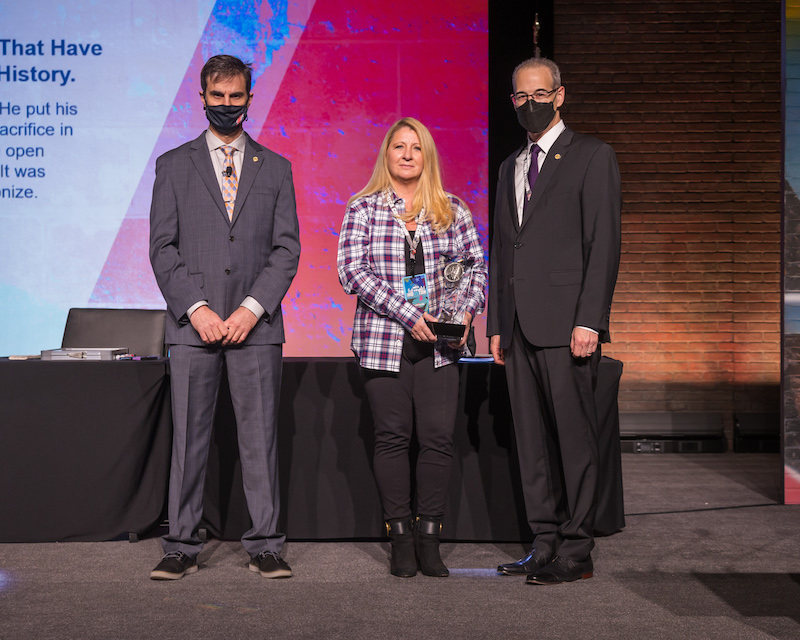
(Presented on Dec. 9, 2021 at the 18th Biennial Convention in Houston.)
Executive Vice President Andrew LeBovidge noted that NATCA has only presented the John Thornton Award to seven members for making contributions that have significantly changed the course of NATCA’s history.
“Today (Dec. 9), we are so proud to present the eighth John Thornton Award – to Trish Gilbert – for her tremendous achievements for our Union and our members,” he said. “I spoke earlier about Trish’s contributions while she was a controller at Houston Center (ZHU). While legislative activism was her specialty and her passion, she had a desire to bring members together in many different ways. Her election as EVP in 2009 coincided with the end of the White Book and the beginning of an era of collaboration with the Agency that she helped create and shape into the way we do business today.”
LeBovidge said Gilbert inspired NATCA’s members to work harder, aim higher, dream bigger, and dig deeper. “There was no challenge too daunting. There was always a way to make every NATCA member’s quality of life better,” he said. “She greatly valued her time visiting our members around the country and listening to them and their experiences and perspectives. In representing our members on the public stage, she was profoundly honored to speak on their behalf and fight for improving the safety of the National Airspace System. She did so forcefully and eloquently.”
Last year, NATCA saw one of its biggest legislative victories, 12 weeks of paid parental leave, codified in federal law. “Trish led our efforts on this issue for many years. It was a collective effort that she championed, like so many others throughout her time as a leader,” LeBovidge said.
“I know I speak for everyone when I say that Trish represents everything NATCA stands for: Solidarity. Passion. Dedication. Sacrifice,” he added. “We ask so much of our member volunteers who give so selflessly to represent their fellow sisters and brothers. Trish did that for so long, day in and day out, and set the ultimate example.”
“I have gotten more from this Union than I ever gave to it,” Gilbert said. “I feel honored to have served in this capacity and been active for so many years for the best profession, I think, in the world. I want to thank you for allowing me to serve and I want to thank you for this recognition. It is really amazing and powerful and I join some amazing, incredible activists that have also received this award, so thank you.”
View award presentation below.
2018: Dean Iacopelli
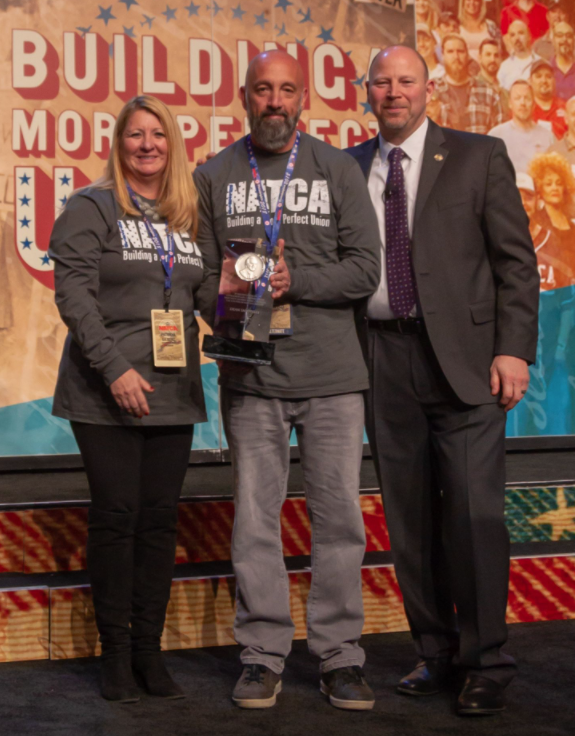
(Presented on April 20, 2018 at the 17th Biennial Convention in Philadelphia.)
Dean Iacopelli is one of NATCA’s most passionate and loyal activists and also one of its fiercest defenders. He was one of the longest-serving FacReps the Union has had. He served the membership at New York TRACON (N90) with great distinction for 13 years, from 2002 to 2015. Prior to that, he was the vice president of the N90 local from 1994 to 2001. He has spent his entire career at N90. He served as Eastern Region Alternate Vice President from 2012 to 2015 before being elected to serve as Eastern Regional Vice President, a position he held from 2015 to 2018.
“He is a valuable asset to this union,” NATCA President Paul Rinaldi said in introducing Iacopelli. “He has made all of our lives better, richer, and stronger, and has made this Union stronger. He is NATCA’s labor giant.”
Iacopelli served on both the 2005 and 2009 contract teams for the air traffic controllers/TMU/NOTAM bargaining unit talks. He was the chief negotiator on NATCA’s 2016 Slate Book contract team that secured a collective bargaining agreement for the air traffic controllers, traffic management coordinators, NOTAM specialists, and Alaskan Flight Service bargaining units. He is an integral part of our very successful collaborative working relationship with the FAA, serving on the Collaborative Working Group.
“I’m honored to be in the same category as those who came before me in receiving this award and I’m honored to have been afforded the opportunity to do the things that I did with the people I did them with,” Iacopelli said in accepting the award.
Watch the award presentation below.
2018: Mike MacDonald
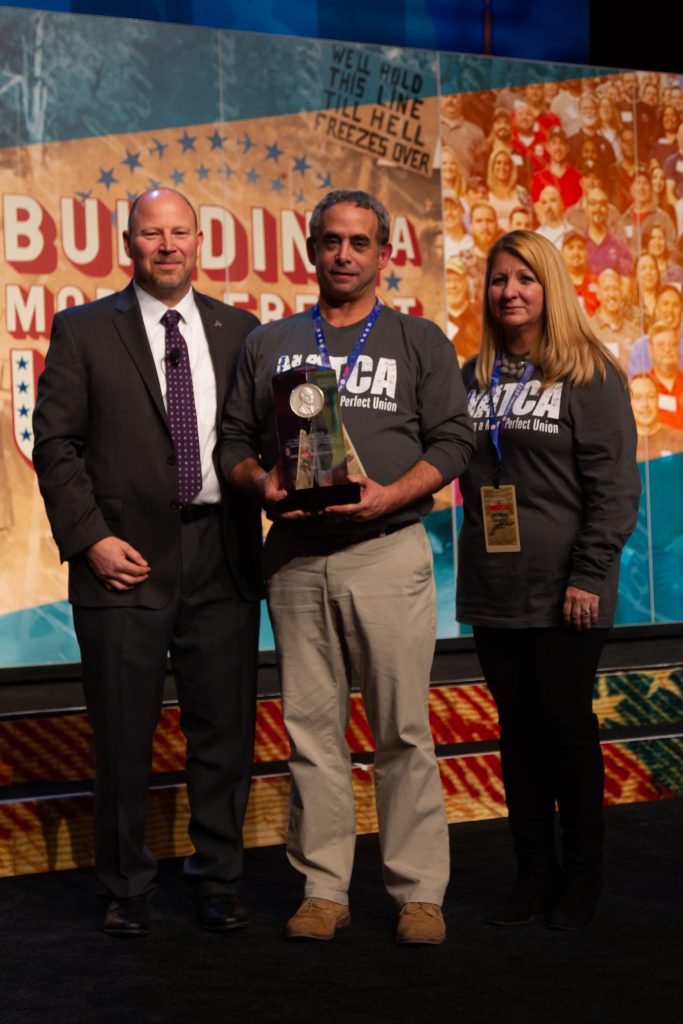
(Presented on April 20, 2018 at the 17th Biennial Convention in Philadelphia.)
In 2018, Mike MacDonald completed his fourth and final term as Region X Vice President. He was elected to this position in 2006. His leadership, vision, and determination helped lead the effort to organize the Engineers and Architects Bargaining Unit back in 1997. It was the start of a large-scale expansion of NATCA’s growth and strengthening into an even more powerful union. The FAA engineers did not have a voice before then. They knew NATCA could provide the resources needed to make their opinions heard. The E&A bargaining unit now has more than 1,300 employees. It’s the largest component of NATCA’s Region X and remains one of NATCA’s greatest organizing success stories.
In 1992, MacDonald was hired as a civil engineer in the FAA’s Airway Facilities Division in the New England Region. Before taking on the NATCA RVP role, Mike worked for many years supporting automation in enroute and terminal facilities as well as center power upgrades and ACEPS battery issues. He has served in many capacities in his career, including as an Equal Employment Opportunity counselor to assist victims of discrimination in the workplace. He has also served as a board member and president of the Federal Employees Child Care of Nashua. He was president of NATCA Local Engineers New England (ENE) and he was the NATCA representative on both the Career Level Descriptor (CLD) and Promotion Criteria Workgroups.
“This great NATCA leader exemplifies leadership, vision, and determination,” NATCA Executive Vice President Trish Gilbert said. “Mike MacDonald has been a trusted advocate and, without doubt, has changed NATCA for the better.”
MacDonald also served as a NATCA arbitration advocate, alternate RVP for Region X, and a member of the 2006 Engineers and Architects Contract Team. In addition, he has served as a member of the Information Technology Committee.
“It’s been a long, good run and I’ve loved every minute of it,” MacDonald said in accepting the award. “I love NATCA and I love all of my brothers and sisters. I’ve been very fortunate to have a lot of support along the way.”
Watch the award presentation below.
2016: Phil Barbarello
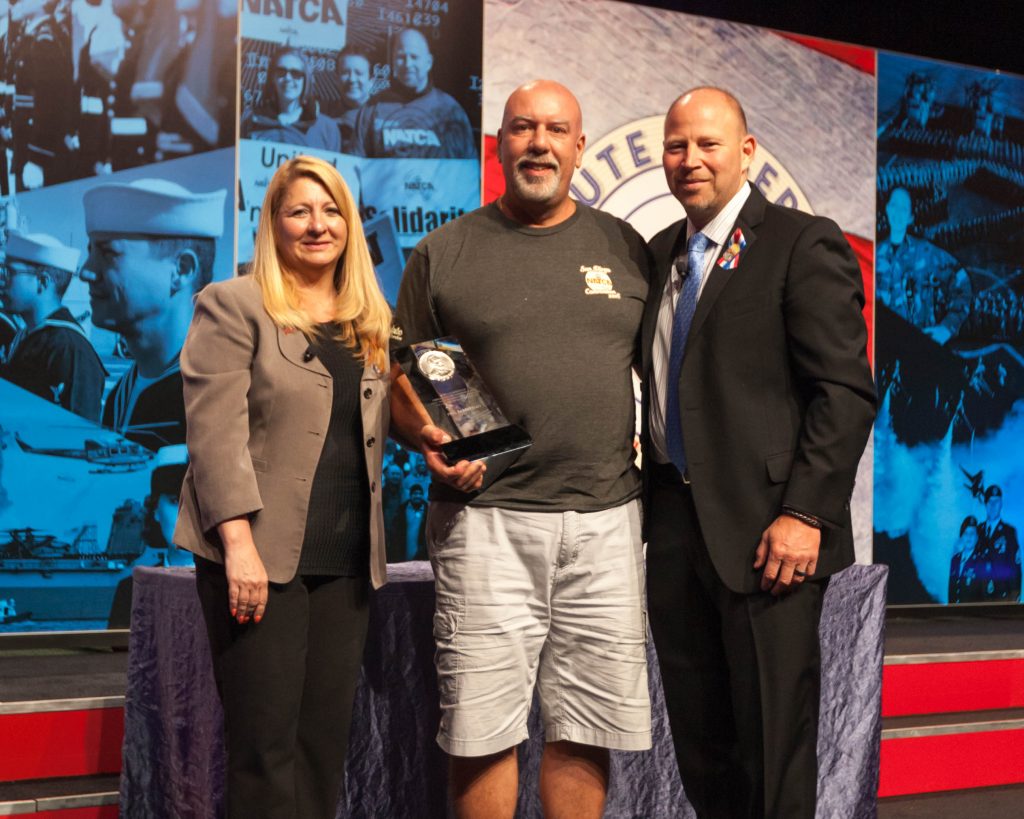
(Presented at the 16th Biennial Convention in San Diego.)
Always friendly. Always supportive of NATCA members. And always dedicated to the Union. That’s Phil Barbarello, who embodies the spirit of the Thornton Award, which, as described by Executive Vice President Trish Gilbert, goes to those rare individuals who, had they not done what they did during their time serving NATCA, “this Union would be different. That’s how important they are to this Union and to the people we represent, and that’s the significance of the award.”
Barbarello spent his entire 30-year career at the New York TRACON (N90) before retiring in 2015.
He served four terms on the NATCA National Executive Board as Eastern Regional Vice President, from 2003 to 2015.
A founding member of the Union, Barbarello has held several key leadership positions since its inception. He was a member of NATCA’s landmark 1998 contract team (the Green Book collective bargaining agreement), served on the 2016 ATC/TMU/FSS/NOTAM contract team (the Slate Book), has served on several national work groups, and has worked on several national air traffic control agreements.
Barbarello also served as chairman of the Drug and Alcohol Committee.
“I can’t thank you guys enough,” Barbarello told the Convention body in accepting the award. “Just to let me hang with you guys and stay with you guys and work with you guys, it is the best thing that could happen to me. Thank you very much.”
Watch the award presentation below.
2016: Dale Wright
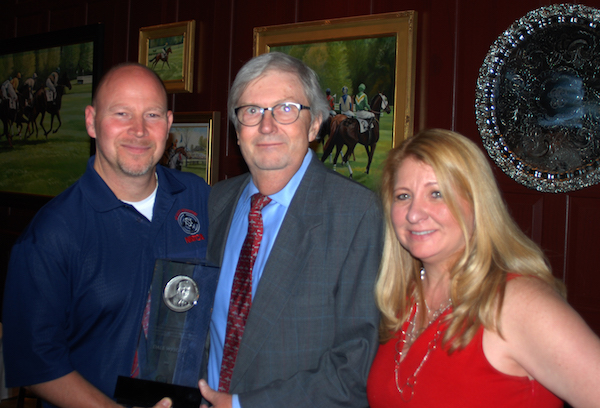
NATCA on Wednesday, May 25, 2016 celebrated the wonderful career of Safety and Technology Director Dale Wright with a retirement dinner honoring his nearly four decades in air traffic control and his tireless work in support of furthering aviation safety, the ATC profession, the workforce, and the Union.
Over 100 people closest to Wright, including members of his family, NATCA leadership and National Executive Board Members, NATCA brothers and sisters, friends, National Office Safety and Technology Department employees, other staff members, and current and former Federal Aviation Administration officials gathered to pay tribute to Wright’s remarkable service to the Union and the National Airspace System.
Wright, whom NATCA President Paul Rinaldi called “a NATCA treasure,” was presented with the Union’s highest honor, the John Thornton Award, which is given in recognition of extraordinary contributions that have significantly changed the course of NATCA’s history.
In accepting the award, and closing the evening in his trademark simple, honest, and professional style, Wright thanked everyone for attending. He relayed one of his favorite axioms for the relationships he has made and kept through the years, saying, “I always went by the guide of treat people like you want to be treated.”
Wright said of his retirement, “it’s time.” He credited his staff at the NATCA National Office; Deputy Director Jim Ullmann, who will succeed Wright as department director next month, Terminal Technology Coordinator Bill Geoghagan, Terminal Operations Coordinator Chris Stephenson, En Route Technology Coordinator Mark Prestrude, Technical Representative Liaison Robert Utley, and Administrative Assistant Pauline Hines.
“They are great to work with, as well as all of the tech reps we have,” Wright said. In addition, he praised the relationship that NATCA has built with the aviation industry.
Wright first began his career in the Air Force, working at Berlin Center in Germany and England Air Force Base in Louisiana before joining the FAA in 1983 in Atlanta. He spent the majority of his air traffic career in Charlotte before retiring from the FAA in 2007 and accepting a position at NATCA as the Director of Safety and Technology.
In 2012, NATCA created a special award in honor of Wright – the Dale Wright Award for Distinguished, Professional, and Exceptional Career Service to NATCA and the National Airspace System. Rinaldi and NATCA Executive Vice President Trish Gilbert presented the first award to Dale at the NATCA Biennial Convention in Denver. Other winners since 2012 include Mike Hull, Ricky Thompson, Tom Morin, Tim Leonard, and Don Chapman.
In 2013, Wright was honored by RTCA – founded as the Radio Technical Commission for Aeronautics in 1935 – with that organization’s highest honor, the Achievement Award. Since that time, Wright continued his great work for NATCA. The details of that, and the deep emotions of appreciation, friendship, and solidarity, were made clear at the retirement dinner, where many of Wright’s closest friends and colleagues went to the podium to speak with one voice of thanks.
“We are truly blessed to have such a great man with us, a true aviator and someone who is committed to aviation safety,” Rinaldi said in opening the evening’s presentations. “Words fall short.” In directing his comments to Wright, Rinaldi said, “You’ve been a friend and mentor, and you see it in this crowd. Thank you for everything you have done.”
FAA Air Traffic Organization Chief Operating Officer Teri Bristol called Wright, “one of the kindest people I’ve ever met.” But she also said Wright, in a compliment to his fierce dedication to safety and the workforce, was one of the “most challenging people to work with, if it’s something he needs to fight for in safety.”
“It’s been an honor to sit beside you,” Bristol added. “You’re one of the true collaborators. With you, it’s not about winning, but what is about what’s right for the system.”
ATO Director of Labor and Employee Development Mark DePlasco said he met Wright 20 years ago with the Standard Terminal Automation Replacement System. He said the two of them have been on opposite sides of the table in discussing issues and it’s been difficult, he said, “because we can read each other so well. It’s such a pleasure to work with you. You have shaped my relationship with NATCA.”
Bristol and DePlasco presented Wright with a framed piece of art featuring Charlotte Tower.
Former NATCA President Pat Forrey saluted Wright’s work with the Union’s National Finance Committee several years ago. Forrey was in office when he had the opportunity to bring Wright to the National Office as director of safety and technology.
“What Dale was and what Dale is, is a great advocate for our Union, whether it’s IFATCA (International Federation of Air Traffic Controllers’ Associations) safety, finance, or director of safety and technology,” Forrey said. “He’s so organized, so detailed. He is so with it. He always had the right perspective on every avenue we pursued and quite frankly, the FAA loved him. They loved what he did. He would stand up for the membership and what’s right for the system and he always did. He served this union proud and the aviation system proud.”
RTCA, Inc. President Margaret Jenny joked that, “I’m still surprised Dale answers the phone when my number comes up. He’s been a go-to person and, reliably, the voice of all of you, the controllers, who work so hard. Dale is devoted to his profession and his colleagues.” Jenny credited Wright as an expert listener. “He takes action about what he hears.”
Retired FAA and Metron Aviation official Jack Fearnsides, said, “I developed a tremendous respect for somebody that came to do the job, do it with integrity and saw it through to the end.”
Former FAA Vice President of Terminal Services Walt Cochran, now with Lockheed Martin, looked at Wright, seated directly in front of the podium, and said “I respect you like nobody’s business. We share that passion for air traffic control.”
Cochran credited Wright for his instrumental role in ushering in a period of great collaboration on safety and technology issues between the FAA and NATCA. “Without Dale’s leadership at NATCA, the implementation of all the safety and tech we have done in the last 10 years maybe would have happened, but not the way they should have happened.”
Wright’s father, Jimmy, was a special guest at the dinner. During his remarks, Cochran acknowledged him and thanked him. “He got his values from you,” Cochran said, looking at Jimmy Wright. “You raised a great son who I am proud to be associated with.”
Ullmann remarked that Wright accomplished something very few people have done – he worked for every one of NATCA’s six presidents. He said Wright helped raise NATCA’s Safety and Technology Department to “a level that is hard to measure.” He said his own work on the En Route Automation Modernization program brought him closer to Wright.
“I was excited to work and learn from someone who has always been there for me just like he has always been there for NATCA,” Ullmann said. “We are fairly simple human beings. We believe in what is better for NATCA, for our workforce, and for the aviation system.” In closing, he told Wright, “don’t change your phone number because I am gonna need you.”
Gilbert followed Ullmann to close the evening by presenting Wright with the John Thornton Award. She said the award honors a select few individuals who, “had they not been a part of NATCA and our profession, and committed to our workforce and the system, we would not be where we are today. Dale Wright is one of those individuals.”
In accepting the award, and speaking to close the special evening, Wright relayed something his father had told him when he was growing up: “He always told me that he didn’t care if I dug ditches, but I had better dig the best ditches there is.” Wright then paused, and said, “I loved being an air traffic controller. That was the job for me.”
2014: Dr. Ruth Stilwell
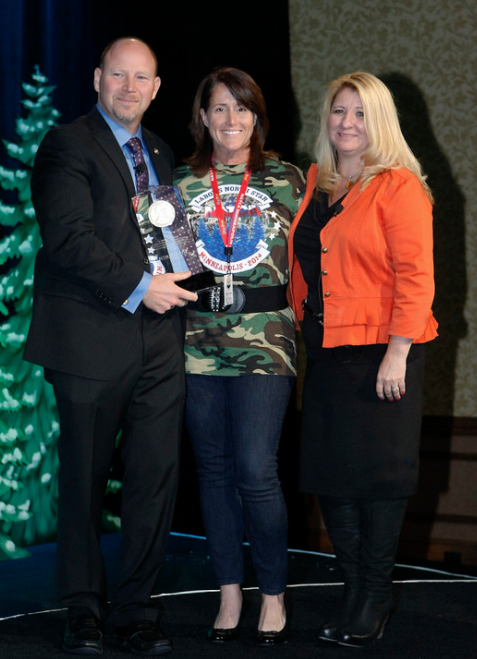
(Presented at the 15th Biennial Convention in Minneapolis.)
NATCA was proud to present the John Thornton Award in 2014 to a dedicated Union sister who has devoted her entire career to safety, professionalism, Union and legislative activism, and improving our profession around the globe.
In 2000, Stilwell was elected as NATCA’s fifth Executive Vice President (EVP) and, along with Carol Branaman (elected in 2000 as Northwest Mountain Regional Vice President), were the first two women to serve on the National Executive Board. In 2003, Stilwell was re-elected, becoming at that time the first EVP to serve two terms.
She has given so much to her home facility, Miami Center, but it is nationally and internationally where NATCA is even more grateful for her service. She has served as the IFATCA Observer to the ICAO Air Navigation Commission. This is a very high-profile position that required her to communicate, negotiate, and partner with representatives from air traffic control organizations from all over the world.
Our members often are informed of air traffic control issues throughout the world but may not realize that NATCA assists many controllers outside the United States through our international work. NATCA works with several organizations in the international air traffic control world. Stilwell was an integral member of this team.
Both Paul Rinaldi, who succeeded Stilwell as EVP in 2006 before becoming NATCA President in 2009, and Trish Gilbert, who was elected EVP in 2009, have praised Stilwell for her counsel and support as well as reminding them to fill the shoes of the office and put the members first.
“Everything we ask of her, she’s there to help us,” said Gilbert.
Stilwell, in accepting the award, said, “there has been nothing greater I could possibly do in my life than serve this Union. It has provided me with opportunities I could never imagine, it has provided my family with pride they could not have embraced more, and it has provided the belief that you have the power to change your future if you work hard enough.”
Continued Stilwell: “I have seen so many people do so many things that I know, when they started, didn’t necessarily know they could. And member after member has done things that people thought were impossible. And it is possible because everyone here stands together, through the good times, through the bad times, through the fights, through the battles. Every time we had a fight, people thought we couldn’t do it and every time we did. This is an amazing organization and this is an amazing opportunity, and I am the luckiest person in the world that for 23 years you let me do it.”
Watch the award presentation below.
2014: John Carr
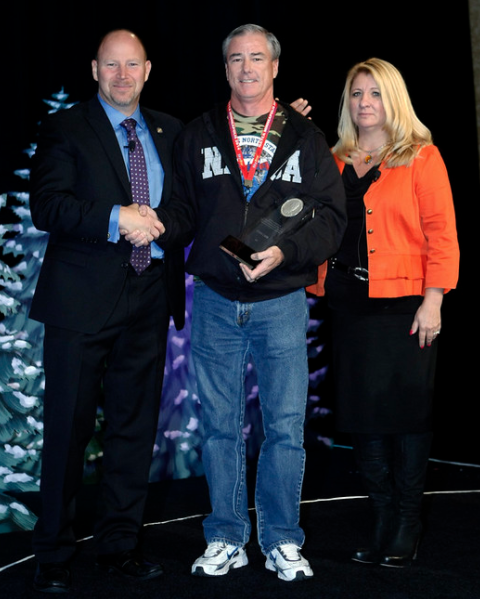
(Presented at the 15th Biennial Convention in Minneapolis.)
NATCA President Emeritus John Carr was elected to lead the Union in 2000. In 2003, he was re-elected, becoming at the time the second NATCA President to serve two terms, joining Barry Krasner.
Carr grew up in the Washington, D.C. area and spent four years as a Navy controller in Corpus Christi, Texas, and aboard the USS Eisenhower. He turned down a job offer from the Federal Aviation Administration (FAA) a few days after the Professional Air Traffic Controllers Organization (PATCO) strike in 1981 but reconsidered when his brother counseled him on his career options.
Five months later, he joined the Agency and soon certified as a controller at Kansas City Tower/TRACON (MCI), where he organized his facility and became the local’s first FacRep. Carr worked for most of his career at Chicago TRACON (C90) where he held all elected NATCA positions throughout his tenure. He also worked at Cleveland Tower/TRACON (CLE). The joy of serving in a variety of positions solidified his dedication to the Union. He became more deeply involved as a facility training instructor and by serving on the 1998 NATCA contract team after then-President Barry Krasner asked him to participate.
Carr earned the nickname Johnny “the Bull” as he began to spread his wings within the Union. His father had been a career civil servant and not a fan of unions, often regarding his son’s NATCA-related efforts as merely a hobby. This characterization did not slow Carr down. The passion that got him elected NATCA President stems from an overriding concern for others and a sense of fairness and empathy tempered with intolerance for reckless authority.
Unlike NATCA’s previous presidents, Carr’s election to the top office was not predicated on National Executive Board experience. Instead, he made the leap using his articulate flair and involvement with the 1998 contract team. Taking the reins of the maturing Union, Carr proved adept at framing public debate on key issues while strengthening communication with the membership and management.
Then-FAA Administrator Jane Garvey said Carr’s communication and leadership played a big role in making NATCA-FAA collaboration a reality.
“He always comes with the notion of problem-solving,” Garvey said. “I don’t think there is anyone better in Washington at capturing the public’s attention. He’s galvanizing. He says the right thing in the right way. It’s great fun to watch him.”
The trade publication Aviation Daily echoed that sentiment when it named Carr the second most-influential person in aviation for 2001. The honor was bestowed in recognition of controllers’ efforts through the tragic events of Sept. 11, 2001, but also underscored the great strides NATCA had made since its inception 14 years earlier. “We fought well above our weight class,” Carr said often. Carr was an outspoken advocate not only for air traffic controllers but for the flying public as well.
Said NATCA President Paul Rinaldi: “He was a master at communication. He governed this organization through some treacherous waters and we are stronger because of his leadership.”
“He inspired our members and he inspired me to do more and reach higher and be stronger,” NATCA Executive Vice President Trish Gilbert said.
Carr currently serves as the Executive Vice President for the Americas Region of the International Federation of Air Traffic Controllers’ Associations. He was elected to that position in 2014 and was re-elected in 2016 and 2018. In addition, Carr regularly speaks to NATCA members around the country about legislative activism and NATCA solidarity.
“I’d like to accept this award on behalf of the NATCA army that isn’t here today, save for my wife Jill,” Carr said. “My wife and four kids are the ones that bore the burden of my absences as we worked together to build this Union; as we worked together to fight our battles; as we worked together to win those battles. And your families deserve this award just as much as mine do.”
Watch the award presentation below.
2014: Barry Krasner
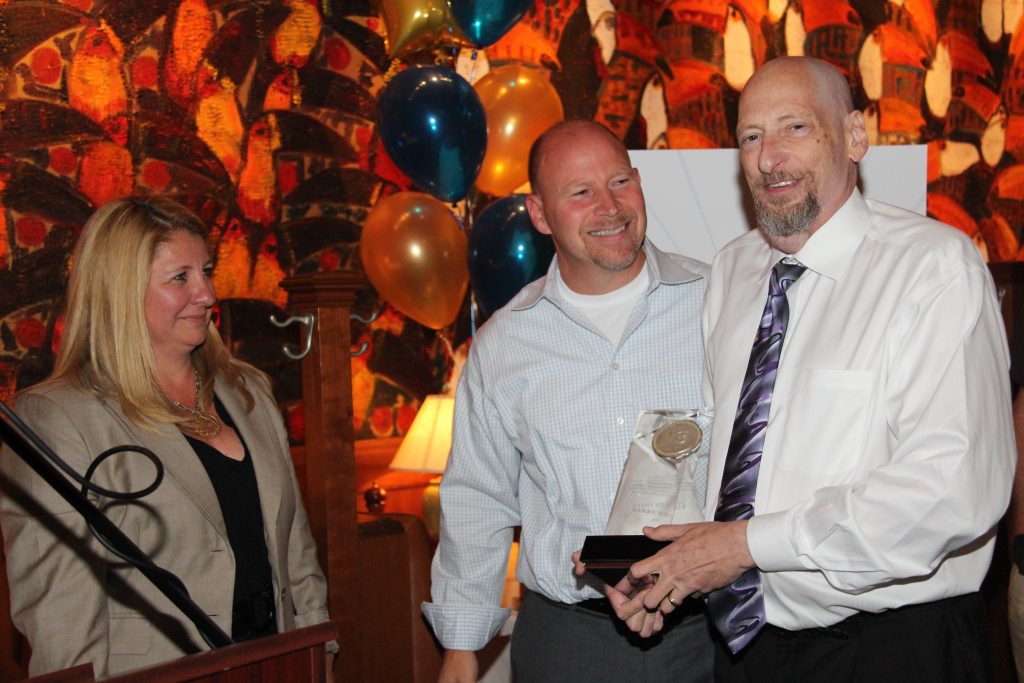
Barry Krasner made a difference.
In the professional and personal lives of every sister and brother who chose to be a NATCA member, and in the never-ending effort to protect the Union’s members and the National Airspace System, Krasner made a profound and everlasting difference. That’s according to the many fortunate members who got to call him a brother and a friend.
“Barry was clearly the right man at the right time and will remain so for generations of air traffic controllers now and forever,” said Joe Bellino, who won election as NATCA’s second executive vice president on July 31, 1991, the same day that Krasner became NATCA’s second president-elect. Krasner and Bellino served together from 1991-94 during the first of Krasner’s two terms.
Krasner, whom NATCA President Paul Rinaldi (pictured at right at the 2010 Biennial Convention in Honolulu) called the cornerstone of NATCA and “set the course for three decades and gave us the guidance and direction we needed,” passed away in 2018 at the age of 65. Executive Vice President Trish Gilbert called Krasner “a NATCA legend, visionary, leader, mentor, and beloved friend.”
Retired member Phil Barbarello, former Eastern Regional Vice President who worked with Krasner at New York Terminal Radar Approach Control (TRACON), said Krasner was of the highest caliber as a Unionist and a friend.
“His eloquent and persuasive way of getting his point across brought us some of the best work and pay rules in the Federal Sector,” Barbarello said. “Barry’s sharp wit was unparalleled whether in a small crowd or chairing a convention. I had the good fortune to visit with him just last month where we sipped some of his most cherished bourbons reminiscing over our years together. He will be missed by many.”

Krasner served as both vice president and FacRep of N90 before being elected as the then newly-certified Union’s Eastern Regional Representative in 1988. Krasner was a member of the negotiating team for NATCA’s first contract, signed in 1989, and was chief negotiator for the air traffic negotiations on the 1993, 1998, and 2005 contract teams. He has also served as chief negotiator for all other NATCA-represented bargaining units.
However, for all of his legendary Union accomplishments in helping to build, lead, and grow NATCA, “I have to believe the thing he’s most proud of is when he was an air traffic controller vectoring airplanes in the LaGuardia Area,” said Eastern Regional Vice President Dean Iacopelli, who was the N90 FacRep when Krasner retired from active FAA duty.
Ruth Stilwell, who served as executive vice president for two terms, from 2000-2006, said that while she is eternally grateful for the support and encouragement that Krasner gave her personally, “he is so much more than the influence he had on individuals. Few people on earth will have the opportunity to change the course of history for a profession; even fewer will seize that opportunity. Barry did with courage, strength and wisdom.”
“If one person can be said to have built a union it is Barry,” Stilwell continued. “He was a leader, a mentor, and advocate but his legacy is so much more than that. In the wake of a great crisis in organized labor, as worker and public sentiment for unions was on the decline, Barry took a workforce, particularly selected as unlikely to support a union and brought them to the highest membership rates in the federal government.”
In 1986, Krasner had been in the Federal Aviation Administration (FAA) for four years and wanted to be involved in shaping its future. Representing his area at N90, he was a member of the FAB (Facility Advisory Board) and was the chairman of the HRC (Human Resources Committee). These were the two workforce involvement groups instituted by FAA management after the 1981 Professional Air Traffic Controllers Organization (PATCO) strike, and the positions were elected from within the areas of operation. Krasner said, “it didn’t take very long to realize what a waste of time they really were.
“I then attended a meeting in the local area where (NATCA’s late founding father) John Thornton wanted to talk to the masses about organizing a new Union called NATCA. I was bit by the bug and have been involved ever since.”
Fellow NATCA founding member Howie Barte, who represented fellow New England Region controllers up to and through the Union’s 1987 certification, recalls first meeting Krasner in March 1986 at a nascent N90 board meeting. Thornton was also present.
“Barry was the vice president of the local. Subsequently we interacted at an increasing rate to the point of friendship,” Barte said. “In 1992, he appointed me Convention Parliamentarian. We went for sushi and sake every time we were together. Barry had an advanced concept of leadership.”
When he decided not to seek a third term as president in 1997, Krasner disappointed many in the Union, like Barte, who felt he had been the best leader they would ever elect. Krasner demurred. If that’s the case, he said, they might as well close the doors right away. “Everybody after me should be better than me,” Krasner said. “Otherwise, we’ve learned nothing.”
By the time the decade of the 1990s ended, Krasner had served as the Union’s first two-term president and was named its first President Emeritus. NATCA had purchased its own office building in Washington, D.C., which it appropriately named after Krasner. The Union had fought and won countless battles in all arenas, had achieved momentous milestones such as achieving pay reclassification, and stormed into the new millennium armed with a landmark contract called the Green Book. It possessed an enormous wealth of confidence and momentum, began to grown its ranks by organizing many other FAA bargaining units of other aviation safety professionals, and saw a rising level of solidarity.
But Krasner would only say he played a small part in the Union’s success. It was the voice of many, not the voice of one, he said, that determined NATCA’s success.
“Going back to our organizing days, we could not even have found our way to the table without the hundreds of dedicated volunteers who were willing to stand together in pursuit of a better life and more rewarding career,” Krasner said. “And this holds true for each and every group of professionals that chose to join the ranks of NATCA over the years.”
Membership in NATCA provides enormous opportunities, both personally and professionally, Krasner believed.
“But with that opportunity comes great responsibility,” he said. “Both individually and organizationally, we have the obligation to leave the system and our professions in a better place than we found them. And the way to do that is to marshal our forces and to channel our energies into one cohesive voice.”
Krasner, by any measure, helped leave NATCA in a better place than when he found it.
“I recall when Barry decided not to run again for president in the mid-1990s and he said, ‘I’m not going anywhere, I’m just steppin’ aside. I’ll be here,’” Rinaldi said. “And he certainly was here for the better part of three decades and he was amazing. Everything that Barry did, you look back on it and marvel at the genius he was at looking to the future and moving this organization forward.”
NATCA National Professional Standards co-lead Garth Koleszar said he is regularly asked for advice on how to become more active and influential in the Union.
“I tell them go to every event, volunteer when you can, and sit at the big kids table and just listen,” he said. “When I was a much younger NATCAvist, Barry Krasner was at the big kids table and when he spoke we listened.”
Koleszar worked with Krasner on the 2009 collective bargaining agreement, the Red Book, which covered the Union’s air traffic controller, traffic management coordinator and NOTAM specialist bargaining units. That experience is where Koleszar says he draws the fondest memories of Krasner, who was a master of leading the team with relentless focus and hard work and also using humor in key moments as a motivating tool.
“I will never forget nervously preparing to present our argument for (Article) 108 to the arbitrators on the last day,” Koleszar said. “He must have sensed my anxiety. He pulled me aside and said ‘Relax, if you mess up, you will only piss off 15,000 of your closest friends. So don’t f— it up.’”
That was vintage Krasner. He was the Union’s driving force, with razor-sharp negotiating skills and an offbeat sense of humor who, during his presidency, placed a stuffed armadillo atop a curio cabinet in his office to stare down visitors.
It’s that humor that Krasner’s wife of 27 years, Sallie Sullivan-Krasner, always wants his brothers and sisters and friends to focus on.
“I once asked him what he would want on his tombstone and he replied, ‘Barry Krasner – He Made a Difference,’” Sallie said. “And oh what a difference he made!”
View a tribute to Krasner (below) at the 2014 Biennial Convention in Minneapolis.

